Dallas Koreatown 101
“Unlike almost every other food culture, the Koreans don’t seemed to have “f*cked up their food the least of all of them. The food didn’t become modified for American tastes.”
Anthony Bourdain, “NYC Outer Boroughs.” No Reservations
I have to agree with Bourdain. Koreans are one of the most homogenous ethnic groups in the world, so it’s no surprise their food even in America has remained relatively “pure”. However this makes Korean food one of the most misunderstood cuisines. When I ask people if they’ve ever tried Korean food, the answer is usually no, unless a Korean friend took them once for Korean BBQ. Korean restaurants in America haven’t helped their cause by marketing themselves, having signs in English and websites, or even being located in areas outside the local Koreatown. So here is an intro to Korean food in Dallas. And don’t worry, there was no consumption of dogs during these visits.
Growing up in L.A., living in New York, and visiting South Korea, I’ve had my fair share of Korean food. Dallas has some pretty decent Korean restaurants, but most of them are in Koreatown or “K-town”. Where is the Dallas’ K-Town? Many local Koreans call it “Harry Hines” since this is the street where it started, just below I-635. I usually say on Royal Lane, just south of I-35 since that’s where most of the restaurants and businesses are these days. I didn’t grow up in Dallas, but apparently Harry Hines Blvd. has a special connotation, a little further south. Again, Korean restaurants need better marketing. Although the people are homogenous, Korean food is pretty diverse. It’s hard to find one restaurant that excels at all the different types of Korean food. Here is a list of some of my favorites and most popular in Dallas. More detailed reviews and pics to come.
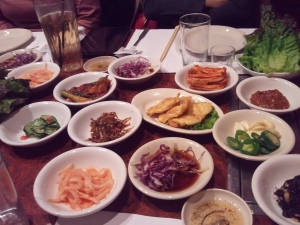 Chosun Galbi
Chosun Galbi
2560 Royal Ln # 105
Dallas, TX 75229
972-406-0087
www.chosunbbq.com
Korean BBQ is one of the most famous types of Korean cuisine. Kalbi or Galbi (beef short rib) is the most popular dish for Korean BBQ. Another pet peeve of mine is that there is no standard English spelling of Korean dishes, so if you can’t read Korean on the menu, it can be confusing at times.
Before they cook the meat, they will give a whole bunch of bachan or side dishes in small plates to be shared family style, so if you have an aversion to this, be warned. Included of course is kimchi (fermented cabbage), probably the most famous side dish. Side dishes are to be eaten as an appetizer and with the meal (you can always ask for more). I remember a few occasions some of my friends would chow down on the side dishes and think this was the meal, so were almost full when the meat courses actually came.
Korean Food Myth #1: All Korean food is spicy
Fact: Not true, but as a general rule, the redder the dish is, the spicier it is due to red chili peppers. Follow this rule with most Korean food.
Korean Food Myth #2: You’ll get better service if you speak Korean.
Fact: Not necessarily. Sometimes I feel I get worse service since I speak Korean, but it might help. It you ever visit South Korean restaurants, people are actually yelling at the wait staff, “Come here!”. Since there is no tipping in many Asian countries, some have speculated that is why service is sometimes slow. Unfortunately, Korean restaurants in America aren’t known for their service either and this annoys me. One innovative product at many restaurants and bars is a wireless bell on the side of the table that will indicate you need service. But this still might not help, so the key is just to be aggressive in flagging the wait staff and if need be, just go get them. I know this is shunned in the U.S., but think about it as part of the cultural experience.
I’m sort of a snob about the order I eat the meats and usually they serve the unmarinated first and then marinated, but sometimes you have to say something if they don’t. I would try these meats in this order if you have a party of 4 or more. With less people, definitely get the yangnyum galbi.
1) chadol baegi (unmarinated thin slices of beef brisket)
2) sam gyup sal (unmarinated pork belly)
3) saeng galbi (unmarianted beef short rib)
4) yangnyum galbi (marinated beef short rib): this is the most popular usually, but a little sweet for my taste. Each restaurant has their own “sauce” and Chosun “licensed” their sauce from a restaurant in L.A. with the same name. Here are some great pics and a review by the BBQ Snob from a recent visit.
Make sure they give you the dipping sauce (just sesame oil with salt) for the unmarinated meats. They should also give you raw garlic slices (you can grill as well), sliced pepper slices, and ssamjang (think Korean salsa or spicy miso bean paste), and pa muchim (seasoned scallions, similar to a salad) to go along with meat. They also give you ssam, which is various lettuce (red leaf, sesame, and cabbage) and you can use as a wrap for meat, rice, the previous mentioned condiments and/or side dishes they’ll give at the beginning of the meal. They will also give small hot stone bowls of gaeran jim (steamed egg) and doengjang jjigae (spicy miso stew) to share.
Both Seoul Garden and Chosun Galbi use real coals instead of gas, which makes a difference, but I still prefer Chosun since the quality of meat seems better. Supposedly USDA Prime according to a sign by the table. Even in L.A. or NYC, only a few places use exclusively coal. Also, Seoul Garden and Omi in Carrollton both have Suwon Galbi, which has an even sweeter sauce than regular marinated galbi. Again, a matter of personal taste, but I prefer the unmarinated galbi, that is if the meat is good. These places have hyu mit (beef tongue) and yook hwe (beef tartare), which I like, but I don’t remember standing them out at Chosun. I don’t get to order it too often since a lot of my Korean friends haven’t even tried these either.
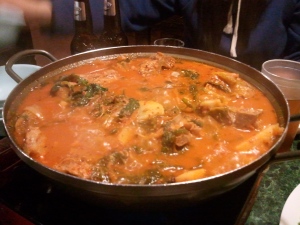 Dal Dong Nae
Dal Dong Nae
11445 Emerald St, Ste 109
Dallas, TX 75229
(972) 484-2994
I was introduced to gamjatang (potato and pork shoulder soup) in Dallas 3am on a weekday a few years. Not a common dish in most Korean restaurants and the order here is for a minimum of 2 people. Gamjatang means “potato stew”, so I was surprised that the real star of the dish is the pork shoulder, which nearly falls of the bone. The stew comes on a burner so you can keep it warm and if it’s a bit too salty, you can always ask for more yooksu (broth). Even with the spicy broth, the pork shoulder might seem a bit bland, so you can always ask for some soy sauce and wasabi to dip the pork meat.
Banchan is solid, as are there other stews such as mixed seafood. Still haven’t a great place for my favorite stew, undaegoo maewontang (spicy black cod stew). Warning that this is a dinner/late night only place, since I learned the hard way a few times they are not open for lunch and don’t open at 4pm. But they are open until 4am, so if you need shrimp fried rice, dukboki (spicy rice cakes), and soup after a late night to sober up, this is the place to go.
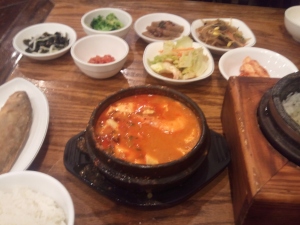 So Gong Dong Tofu House
So Gong Dong Tofu House
11181 Denton Dr Ste 108
Dallas, TX 75229
(972) 241-0200
I think it’s easier to enter from Harry Hines Blvd. and is located in the back of a shopping plaza called Plaza Latina. Just look for a huge green sign and drive towards the back. Interior is actually pretty nice compared to my favorite soondubu jjigae (tofu stew) place in L.A. with the same name. Not the same taste here, but still good. Banchan is good. I usually order the haemul soondubu (seafood with shrimp, clam, and oyster), but you have options of seafood, beef (small bits), or mixed seafood/beef. You can also order not spicy, spicy or very spicy. When the soondubu comes out, you have an option of adding a raw egg on top of the boiling hot stew, but I usually don’t since I like a “cleaner” taste of the stew. Also, each order comes with a small fried fish and rice from a stone pot, which they will add hot water at the end of the meal if you want nurungji (scorched rice at the bottom of the pot).
You can always get even more food by ordering the soondubu/galbi combo, but the galbi is L.A. galbi style (meat is cut in thin slices across the bones on the “Lateral Axis”) and is not my favorite.
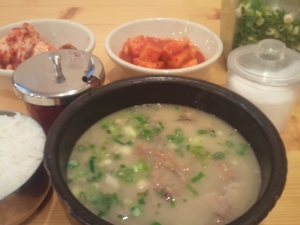 LA Hanbat Sulung Tang
LA Hanbat Sulung Tang
2257 Royal Ln
Dallas, TX 75229
(972) 484-2002
Hanbat is probably the most famous and popular sulungtang place in L.A., so why not just use the same name in Dallas? Koreans aren’t very original with restaurant names. The menu is limited, but there is only thing to get here and it’s in the name of the restaurant. Sulungtang (soup made from ox bones) is cloudy white with slices of brisket and a little bit of rice noodles on the bottom. I heard it was originally peasant food, but isn’t all great comfort food? It comes out bland, so you can add salt, scallions, or red pepper paste . The only banchan is Napa cabbage and radish kimchi (ggakdugi). Kimchi is not my favorite banchan. but is essential since sulung tang doesn’t have much kick. The ggakdugi here is pretty good and usually have to ask for more.
You can also get flank, intestine parts, tongue, or a mix of any meat, but I usually just get brisket. If none of this sounds appetizing, there is mandoo guk, (dumpling soup) which uses the same broth and is pretty good as well.
Sulung tang is great for a cold winter’s day or the day after a long night. Too bad this place closes early because if it was open as late as Dal Dong Nae, I would be a more frequent customer.
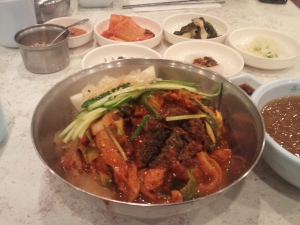 You Chon
You Chon
2254 Royal Ln
Dallas, TX 75229
(972) 243-1818
When I moved to Dallas, I was excited to see a You Chon here too, but slightly different spelling (Yu Chun in L.A.). Known for their chic naengmyun (arrowwheat cold noodles), instead of the normal flour you get at most Korean restaurants. Mul naengmyun, literally means naengmyun in water (since the noodles are in a cold broth) and is the signature dish. Great summer meal in the ridiculous 100+ Dallas heat. But there are no slices of meat in this version, so I end up ordering the hwe naengmyun (literally sashimi, but usually skate) and asking for a side of the icy cold broth to replicate the mul naengmyun experience. Skate is probably not for everyone, since it’s chewy, but it’s the standard hwe naengmyun ingredient. Banchan is weak here if you just order naengymun.
Their kimchi mandoo (dumplings) is pretty good. They’ve expanded their menu over the last few years and the donkatsu, soups and strews are actually not bad, plus they will give more variety of banchan. But don’t get the chicken wings they get from Chicken Plus next door. If you’ve ever had good Korean chicken wings elsewhere, you will be disappointed.
Next posting. Dallas Koreatown 201: More Restaurants, Drinks, Bars, and Noraebangs